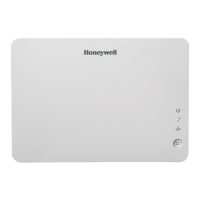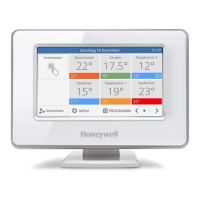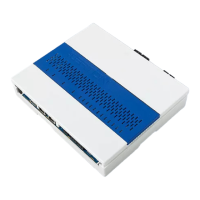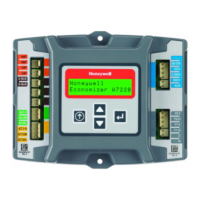ENGINEERING CMANUAL OF AUTOMATION CONTROL
AIR HANDLING SYSTEM CONTROL APPLICATIONS
259
18 Mixed air temperature is for operator
information.
19 SA temperature setpoint is reset based upon
OA temperature.
20-22 Mixing dampers modulate for free cooling.
23,24 Mixing box static pressure maintained
constant during noneconomizer mode by
modulation of the RA damper during
minimum ventilation periods to maintain
constant OA airflow.
25-27 Hot water valve, mixing dampers, and chilled
water valve modulated in sequence to
maintain SA temperature setpoint.
28,29 SA temperature setpoint switches from cooling
to heating value during warm-up modes.
30 RA temperature determines end of warm-up
mode.
32 Control program coordinates return fan
airflow setpoint, loading, exhaust fan control,
and fan interlock.
33 Control program coordinates temperature
control of mixing dampers, control valves,
and fan interlock.
FEATURES
1. The system admits outdoor air for cooling based upon
the economizer program decision.
2. Supplies constant temperature variable volume (energy
conserving) air to VAV boxes during cooling mode.
3. Provides constant airflow of OA in summer with varying
supply airflow.
4. Return fan airflow varies with supply fan airflow
dependent upon exhaust and pressurization requirements.
5. Provides 100% RA during warm-up periods.
6. Perimeter boxes provide heat when required.
7. SA temperature setpoint is reset based upon OA
temperature.
NOTE: This function has no hardware cost. The setpoint
parameters are easily adjusted and can be nulled by
setting the -5°F OA SA setpoint the same as the 40°F
OA SA setpoint.
CONDITIONS FOR SUCCESSFUL OPERATION
1. Skilled HVAC technicians required for pressure and
volumetric setup.
2. Test and balance OA damper minimum position value
and mixing box static pressure setpoint value.
3. OA and RA dampers maintained and provided with
proper actuators (with positioners if pneumatic).
4. Airflow elements and transducers kept clean and calibrated.
SPECIFICATIONS
See FAN SYSTEM START-STOP CONTROL.
Anytime the supply fan runs, the return fan shall start and
the control system shall be enabled. Also, anytime the supply
fan runs during scheduled occupancy periods, mixing dampers
shall position to minimum ventilation position and the exhaust
fan shall start.
Anytime the economizer mode is enabled, the temperature
controls shall be enabled to override the AHU mixing dampers
minimum ventilation setpoint for free cooling as required.
During non-economizer occupied periods the RA damper
shall be modulated to maintain a constant mixing box negative
static pressure.
The supply fan loading shall be under EPID control with a
start value of 20% and ramp duration of 150 seconds. The supply
fan shall load to provide design static pressure at the end of the
longest duct.
The return fan loading shall be dependent upon the supply
fan airflow. When in the recirculating mode, the return fan
airflow setpoint shall equal the supply fan airflow plus a
positive or negative value for calibration (of flow elements
and transducers) so as to provide a neutral space static pressure.
Anytime the OA dampers are not closed completely, the return
fan airflow setpoint shall equal the supply fan airflow minus a
value necessary to maintain a slightly positive (0.05 in. wc)
space static pressure. Anytime the exhaust fan operates, the
return fan airflow setpoint shall be further reduced by additional
airflow value equal to the exhaust airflow (this exhaust value
shall be determined by observing the space static pressure as
the exhaust fan starts and stops).
The SA temperature shall be under EPID control with a start
value of 33 (at which point the hot and chilled water valves are
closed and the mixing damper override signal is zero) and a
ramp duration of 120 seconds. The hot and chilled water valves
and the mixing dampers shall be modulated in sequence to
maintain the SA temperature setpoint.
Anytime the optimum start perimeter zone space temperature
sensor is less than 70°F at startup time, the SA temperature
setpoint shall be 90°F until the RA temperature rises to 74°F, at
which time the SA temperature setpoint shall be lowered to the
cooling SA setpoint. The SA EPID shall be invoked at the
switching of the setpoint to cooling with a start value of 33 and
a ramp duration of 180 seconds. The cooling SA setpoint shall
rise from 55°F to 61°F as the OA temperature drops from 40°F
to -5°F.

